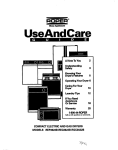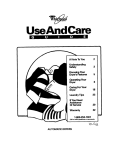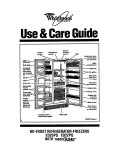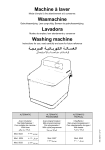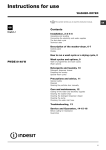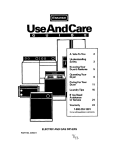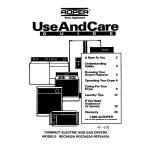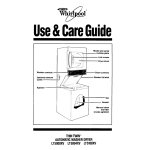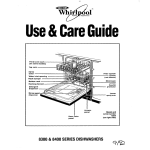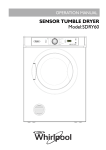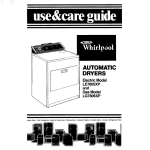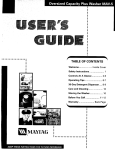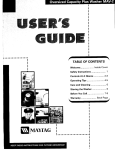Download Whirlpool BYCCD3421W0 User's Manual
Transcript
UseAndCare A Note To You 2 3 # Knowin Your Dryefs lsatu res 4 Operating Your Dryer 5 &Zg F0r Your 9 Laundry Tips 11 y&zne orsenke 18 Warranty 20 1-800-253-1301 cdluswithquestions orcommonb. COMPACT ELECTRIC DRYER A Note To You Thank you for buying this appliance. You have purchased a quality, worldGiless home appliance. Years of engineering experience have gone into its manufacturing. Use this Use and Care Guide to safely and efficiently operate and maintain your appliance. Complete and mail the Ownership Registration Card provided with your appliance. This will help us notify you about any new information on your appliance. Your safety is important to us. This guide contains safety symbols and statements. Please pay special attention to these symbols and follow any instructions given. Here is a brief explanation of the use of each symbol. This symbol will help alert you to such dangers as personal injury, bums, fire and electrical shock. Our toll-free number, l-80&253-1301, This symbol will help you avoid actions which could cause product damage (scratches, dents, etc.) and damage to your personal property. is available 24 hours a day. If you have a question concerning your appliance’s operation, or if you need service, first see ‘If You Need Assistance Cr Service” on page 18. If you need further help, call us. When calling, you will need to know your appliance’s complete model number and serial number. You can find this information on the model and serial number label (see diagram on page 4). For your convenience, we have included a handy place below for you to record these numbers, the purchase date from the sales slip and your dealer’s name and telephone number. Keep this book and the sales slip together in a safe place for future reference. Model Nuder Dealer Name Serial Number Desk Purchase Date 2 Phone IMPORTANT SAFETY INSTRUCTIONS To reduce the risk of fire, electrical shock, or injury to persons when using your dryer, follow basic precautions, including the following: l l l l l l Read all instructions before using your dryer. Do not machine wash or machine dry items cleaned, washed, soaked in, or spotted with wax, paint, gasoline, oil, dry cleaning solvents, and other flammable fluids. The fumes can create a fire hazard or explosion. Always hand wash and line dry items containing these materials. Do not allow children to operate, play with or crawl inside your dryer. Supervise children when your dryer is used near children. Do not reach into a dryer if the drum is moving. When removing from service or discarding a dryer, always remove the door to prevent accidental entrapment. Do not dry rubber, rubber-like, and heat sensitive materials with heat. Understanding your l l l l l l l Install and/or store dryer where it will not be exposed to the weather. Do not tamper with the controls. You are responsible for making sure that your dryer is installed, repaired and has parts replaced by a qualified person. Use only fabric softeners specifically labeled as not being harmful to the dryer. Do not allow lint to build-up inside the dryer or exhaust system. Cleaning should be done periodically by a qualified person. Clean lint screen before or after each load. Do not let dust, lint, paper, rags, chemicals, etc. pile up around or under the dryer. Dryer must be electrically grounded. See the Installation Instructions. responslbllities Never operate the dryer if: -it is not working right (i.e. noisy, too hot). -it is damaged. -parts are missing. -all panels are not in place. -the lint screen is loose, damaged or missing. l Unplug the power supply cord or turn off electrical power before attempting to service your dryer. . Do not wash or dry items that are soiled with vegetable or cooking oil. These items may contain some oil after laundering. Due to the remaining oil, the fabric may smoke or catch fire by itself. l Store flammable solvents or fluids away from your dryer. l Dry cleaning solvents or fluids should never be put directly into your dryer. l l l Be sure that your dryer: -is properly installed and leveled on a floor that can support the weight in a well-ventilated room.* -is connected to the proper outlet and electrical supply.* -is properly connected to fuel and exhaust systems.’ -is not installed against draperies or curtains, or on carpet.’ -is located in an area where the temperature is above 45°F (7°C). -is properly maintained. -is used only for jobs normally expected of home clothes dryers. -is not used by anyone unable to operate it property. *See the Installation Instructions for complete information. - SAVE THESE INSTRUCTIONS 3 Knowing Your Dryer’s Features The parts and features of your dryer are illustrated below. Become familiar with all parts and features before using your dryer. Moioture Optional mounting kits You can mount your compact dryer above your compact washer using one of the following: l Dryer Stand Kit for permanent installation, secured to the wall. Part No. 695570 (electric only) l Stack Kit for free-standing installation. Part No. 346721 (electric only) l Stack Kit to mount dryer permanently onto the washer. Almond Part No. 3390196 (electric only) White Part No. 3390175 (electric only) 4 Dryer Wall-Mounting Kit for securing the dryer to the wall with a steel bracket. Part No. 345994 (electric only) l NOTE: The wall must be strong enough to support the dryer’s weight, (Do not use in mobile homes.) Optional l deflector kit Exhaust Deflector Kit to move dryer exhaust up, down, or to the side. Part No. 346001 (electric only) Operating In This Section Botorol brting Starling Your Dryer or stopping Page Paw your &yr .. .... .... .... ... .... .... .... ... . 5 your byor . . . . . . . . . . . . . . .. . . . . . . . 5 End of cyck Selecting signal . . . . . . . . . . . . . . . . . . . . . . . . . . . . . . . . . . . . . . . . . . . . 5 a cycle . . . . . . . . . . . .. . . . . . . . . . . . . . . . . . . . . . . . . . . . ..s.... 6 Operating your dryer properly assures the best drying results. This section gives you important information to help you to select a cycle, time, and temperature. Before starting your dryer NOTE: Remove any hang tags or temporary labels before using your dryer. Wipe dryer drum with a damp cloth to remove dust from storing and shipping. Refer to the information below, and ‘Laundry Tips” on page 11 for control setting, sorting, and loading information. Starting Starting or stopping your your dryer dryer Close the door and select a cycle. Push the Start Button. See pages 6-6 for additional setting information. Your dryer automatically stops when a cycle ends. Stopping dryer and restarting your Open the dryer door or turn the Cycle Control Knob to OFF. Close the door; make new selection (if necessary). Push the Start Button. NOTE: The Cycle Control Knob should point to an OFF area when the dryer is not in use. If the dryer is stopped before the cycle is finished, turn the Cycle Control Knob to an OFF area. End of cycle c @Q \ ‘&/\ signal The dryer sounds a signal to let you know when the cycle is finished. The signal is not adjustable and cannot be turned off. The signal is helpful when you are drying permanent press, synthetics, and other items that should be taken out as soon as the dryer stops. 5 Selecting a cycle Use pages 6 to 6 to find information about drying cycles that may be on your model. To Select a cycle: 1. Turn the Cycle Control Knob either way to a desired time or setting. 2. Stop when the indicator points to the cycle you want. 3. Push the Start Button. Changing a sdectlon: 1. Turn the Cycle Control Knob to point to a new setting. 2. Push the Start Button, if necessary. NOTES: Use the Energy Preferred Automatic Setting (w) to dry most loads. See page 7. The last few minutes of all cycles are without heat to make the load easier to handle. To help reduce wrinkling, remove the load from the dryer as soon as tumbling stops. This is important for permanent press, knits, and synthetic fabrics. . Do not overdry. Overdrying can cause shrinkage, static cling, and damage some fabrics. l l l Fire Hazard Do not dry heat-sensitive fabrics, plastic, rubber, or some stuffed items with heat. Use the Air cycle or line dry. Failure to do so could result in fire or damaged items. Using the Air cycle (no heat) The dryer does not heat when the Cycle Control Knob is set in the Air cycle. This cycle can be used to fluff or air dry bedding, plastic tablecloths, foam pillows, sneakers, etc. 1. Turn the Cycle Control Knob to the number of minutes you want in the Air cycle. (Cycle is unheated.) Refer to the chart on page 8 for suggested times. 2. Push the Start Button. NOTE: Repeat steps above if more time is needed to dry items. 6 Using cycle the Perm. Press /Reg. Use the Pen. Press/Reg. cycle to dry permanent press and some synthetic fabrics. Your dryer senses the dryness of the load and automatically shuts off when the selected dryness is reached. For the first few loads: 1. Set the Cycle Control Knob to point to the asterisk (a) in your Perm. Press/Reg. cycle. 2. Feel the dried items when the dryer stops. If the load is drier than you Ilke, select LESS dry the next time you dry a similar load. . If the load is not as dry as you like, complete drying using the Timed Drying cycle. Select MORE dry the next time you dry a similar load. The Cycle Control Knob will not move until the load is almost dry or cool-down is reached. After cool-down is complete, the Cycle Control Knob automatically moves to an OFF area and tumbling stops. l Using the Timed Drying cycle Use the Timed Drying cycle to complete drying if some items are damp after Perm. Press/Reg. cycle drying. Timed Drying is also useful to dry delicate items that require a short drying time, or large bulky items. 1. Turn the Cycle Control Knob to the number of minutes you want in the Timed Drying cycle. 2. For a damp dry, turn the Cycle Control Knob to 30 minutes or less. The last few minutes of this cycle are without heat to help make the load easier to handle. 7 Selectina - --_ -----” the _--_ riaht --w--- cvcle - , --- and ---- rettina -------I MODEL TYPE OF LOAD COTTONS AND LINENS Extra Heavy-Sedspreads, mattress pads, quilts Heavyweight-Towels, jeans, corduroys, work clothes MediumweightSheets, cotton underwear, diapers Lightweight-Satistes, organdies, lingerie PERMANENT PRESS, SYNTHETICS AND BLENDS Heavyweight-Work clothes, jackets, raincoats Mediumweight-Shirts, play clothes, sheets, slacks Lightweight-Lingerie, blouses, dresses KNlTS Heavyweight-Cottons, rayons, blends, T-shirts, slacks, shirts Mediumweight-Synthetics (polyester, acrylic, etc.), dress slacks, skirts, sweaters Lightweigh-ynthetics (polyester, acrylic, etc.) and blends, lingerie, blouses, dresses BYCCD3421 Timed Drying Perm. Pressmeg. 90-105 min. Perm. Press/Reg. Perm. PressIReg. Perm. Press/Reg. Perm. Press/Reg. Perm. Press/Reg. Perm. Press/Reg. Perm. PressIReg. Perm. Press/Reg. DELlCATE FABRICS Sheer curtains (2 or 3 panels), gauze, lace, etc. Air 20-30 min.’ RUBBER, PLASTIC, HEAT-SENSlTIVE FABRICS Foam Rubber-Pillows, bras, stuffed toys PlasticAhower curtains, tablecloths Rubber-backed rugs Olefin, Polypropylene, Sheer nylon Air Air Air Air 20-30 20-30 40-50 15-20 ‘Reset Air cycle as needed to complete drying. 8 CYCLE min.* min.’ min.’ min.’ Caring For Your Dryer In Thi8 Section PW Mminbnma-wwy tmd ..I_....-I..........u.......0 PW Mmintmmmdm nasdod . . . . . . . . . . . . . . . . . . . . . ..“......... 0 Dryers require regular maintenance. Follow the suggestions below to maintain your dryer property. Maintenance-every Cleaning the lint load screen The lint screen is located inside the dryer drum, on the back wall. Cken Y beton oath Kurd. A soreen blocked by lint can increase drying time. 1. Open the door and pull the lint screen straight out. 2. Squeeze body of lint screen lightly white pulling the cover off. See itluatration. 3. Roll lint off the screen with your fingers. Do not rinse or wash the screen to remove lint. Wet lint is hard to remove. 4. Replaoe cover on lint soreen body. Push the lint screen firmly back into place and close the door. Maintenance-as needed Use the following suggestions about cleaning and lint removal to maintain your dryer and keep it operating efl iciently. Cleaning a clogged lint screen Laundry detergents and fabric softeners can cause a residue build-up on the lint screen. A clogged lint screen can extend drying times. Clean the lint screen every six months or more frequently if it becomes clogged due to a residue build-up. Use the following method: 1. Wet both sides of lint screen with hot water. 2. Wet a nylon brush with hot water and liquid detergent. 3. Scrub lint soreen with the brush until all residue build-up is removed. 4. Rinse with hot water. 5. Thoroughly dry lint screen with a clean towel and replace in dryer. Do not run the dryer with the lint screen loose, damaged, blocked or missing. Doing so can cause overheating and damage to both the dryer and fabrics. Lint screen COVU Cleaning the dryer interior Garments which contain unstable dyes, such as denim blue jeans or brightly colored cotton items, may discolor the dryer interior. If you want to remove stains from dryer drum, use powdered laundry detergent. 1. Make a paste with detergent and very warm water. 2. Apply paste to a soft cloth and scrub area until all excess dye is removed. 3. wipe thoroughly with a damp cloth. 4. Tumble a load of rags to dry. Cleaning the dryer Electrlcnl shock, Personal lnJury, Ftro, and Ex~loslon Hazard l Turn off the electrical power before cleaning the interior. l Make sure the dryer is cool. l Use nonflammable cleaner. Failure to do so coutd result in electrical I shock or injury, fire or explosion. exterior Wipe with a soft, damp cloth. Removing accumulated lint Lint oan gather inside the dryer and be a fuel for fire. It is recommended that lint be removed every 2 to 3 years, or more often, depending on dryer usage. Cleaning should be done by a qualified person. If you have any questions, please cell our toll-free number at 1-800-253-l 301. Electrkal Shock and Personal injury Hazard l Unplug the power supply cord, or turn off the electrical power at the main power supply before removing dryer panels. l Make sure the dryer is cool. l Dryer parts can have sharp edges. Use care when handling. Failure to do so could result in electrical shock or personal injury. 1. Unplug the power supply cord, or turn off the electrical power at the main power supply. 2. Remove back panel. 3. Remove lint from shaded area in illustration with a soft brush or vacuum cleaner. Avoid damaging wires or thermostats. 4. Replace panel; reconnect and level dryer again, if necessary. 10 Thumostata Hsst siomont Ebctrk dryer with back panel removed Laundry Tips I In This Section Pam Befor. you dry I ................................................ Drying spocklcuo Using byw saving fabrk mergy ii cum “..” ........................................... Vacation itmms ................................ 12 Voltaga raquirullonts ............................ 15 SoMng kundulng softmus .................................................. .................................... probkms ....................... 15 15 16 15 This section reviews proper drying techniques, gives you additional drying information, and discusses causes or solutions to common drying problems. Before you dry Before using your dryer, see page 3 for Important Safety Information. Drying l l l l l l l Sorting l tips Close zippers, snaps, and hooks to avoid snagging other items. Remove pins, buckles, and other hard objects to avoid scratching the dryer drum. Remove heatensitive trim that can y drying. Check gaments to make sure all spots and stains were removed during the wash. If stains were not removed, do not tumble dry. Heat may permanently set stain. Soiled items can also leave stains on the dryer drum. These stains can be picked up by other items in the load. Sharp or metal objects can damage your dryer. Check pockets for pins, clips, money, bolts, nuts, etc., and turn pockets inside out. Do not lay these objects on your dryer after emptying pockets. Tie strings and sashes so they will not tangle. Turn lint takers and dark items inside out to help prevent lint pickup. Place small items such as baby socks or hankies in a mesh bag for easier removal. Articles to be ironed should be removed from the dryer while still damp. l Separate dark from light colors; colorfast from noncolorfast. Items properly sorted for washing are usually properly sorted for drying. Separate heavy fabrics (denim, towels) from light fabrics (synthetics, permanent press). Separate lint givers (towels, chenille) from lint takers (corduroy, synthetics, permanent press). When possible, turn lint takers inside out. Load sizes @Mix large items with smaller items. Load the dryer by the amount of space items take up, not by their weight. Do not overload the dryer. Overcrowding causes uneven drying and wrinkling, and can cause items to wear out faster (because of pilling). l You may need to rearrange large items (sheets, blankets, tablecloths) during a cycle to reduce balling or rolling up. l Reduce wrinkling of permanent press and synthetics by drying smaller loads and removing items from the dryer as soon as tumbling stops. l For better tumbling action when drying only a few small items, add one or two lint-free towels. This also prevents small, lightweight items from blocking airflow. 11 Drying special-care items Most garments and household textiles have care labels with laundering instructions. Always follow label directions when they are available. General drying instructions for some special washables are included in this section. Alr drying (heat sensitive items) Heat-sensltlve kbrks l Olefin, polypropylene, sheer nylon l Cotton and canvasshoes Pillows, sturfed toys l Feather, foam, polyester Heat sensitive fabrics, plastic, rubber or some stuffed items require drying without heat. Use Air cycle or line dry. Air cycle is useful for fluffing bedding and pillows, and dusting draperies and clothing. See Warning on page 6. Follow care label directions. If shoes can be machine laundered: 1. Place several bath towels in the dryer to act as a buffer. 2. If rubber or foam rubber materials are part of the shoe, use Air cycle. For other materials, see page 8 for cycle, time or temperature recommendations. 3. Remove shoes from dryer while still damp and allow to air dry. If manufacturer recommends machine drying, dry one pillow at a time and: 1. Make sure coverings are securely stitched. 2. Shake and fluff the items by hand several times during the cycle. 3. Make sure pillows are completely dry. Feather pillows take a long time to dry. Plastic, rubber #ems l Shower curtains, tablecloths, baby panties Follow care label directions. Scatter rugs Follow care label directions. 12 Blankots lnooknr and 1Cotton, rayon, synthetic blankets 1Electric blankets, electric sheets, woolen blankets, washable woolen garments Machine drying knitted woolens is not recommended. Block to shape when wet and allow to air dry. Line dry blankets in shade on a breezy day over two lines. Pin edges together and straighten them. When partly dry, turn the blanket over, repin and restraighten. When dry, brush nap. Dry as recommended for permanent press fabrics on page 8. If manufacturer recommends machine drying: 1. Place one or two dry towels in the dryer and preheat 3-5 minutes on a high setting. This will dry blankets faster and help avoid pilling. 2. Put blanket in dryer with warm towels. Set control for 20 minutes. 3. Check after 10 minutes. Remove when still damp. Overdrying and long tumbllng can cause shrinking and pilling. 4. Place blanket on flat surface or over two lines to finish drying. Gently stretch to original size and shape. 5. When completely dry, brush gently to raise nap. Press binding with cool iron if needed. Curt&m, BIlpcoverr Remove drapery weights and hooks before laundering. For slipcovers, replace while still slightly damp. They will dry to fit tightly. 1Draperies, slipcovers Dry only a few minutes. 1. Leave room in dryer for load to fluff. 2. Remove from dryer while slightly damp. Do not overdry. t Sheers, some synthetic curtains 1Bonded or laminated fabrics Dry only a few minutes. Dlrporr, :lothes Elastic baby Items FIberglass matorlalr Line dry these items. Wash and dry small items in a mesh bag or pillowcase for convenient handling. 1. Dry according to manufacturer’s instructions. 2. Remove diapers and cotton knit items while still slightly damp. They will feel softer, shrink less, and be easier to fold. Remove from dryer while still slightly damp. Do not machine wash or dry fiberglass materials. Small particles can stick to fabrics washed or dried in following loads and cause skin irritation. continued on next page 13 FIrme retardant flnlshos Nap-d l Some items have been treated with a flame-retardant finish to improve their resistance to burning. Such items are clearly labeled. To retain flameretardant qualities through continuous use and washing, clean and dry according to the manufacturets instructions. Items Dry separately or with similar colors to avoid lint transfer. Follow care label directions. 1. Dry according to manufacturets instructions. 2. Remove from dryer while there is still a trace of moisture. 3. Smooth, reshape and air dry before putting away. Corduroy, velveteen Oulltod, downfllkd Items Follow care label instructions. 1. Dry one at a time. 2. Remove from dryer and shake or fluff the item during the drying cycle. 3. Smooth and reshape before putting away. Snowsulk, Jackok Check label for fiber content, then follow care label directions. l Nylon, polyester-base Dry according to manufacturer’s instructions. 1. Dry garment for about 10 minutes. Remove and turn inside out. Dry for 10 more minutes. 2. Remove from dryer immediately and hang on a nonrusting hanger to finish drying. This will help eliminate wrinkles. Tlntod, dyed or nonoolorfast Items Dry according to fabric, weight and care label instructions. Wipe the dryer drum carefully to remove any dye or lint that can be transferred to other loads. See “Cleaning the dryer interior” on pages 9 and 10. Towels Select cyde according to fabric type. Some towels, particularly those made of a blend of synthetic fibers and natural fibers (polyester and cotton blends), may shed more lint than other towels causing your dryer’s lint screen to get full faster. Be sure to remove lint from the dryer lint screen before and after drying new towels. Washable 14 knlts Do not overdry knits. Overdrying can cause shrinking and static cling. 1. Select cycle according to fabric and construction. 2. Turn synthetics and blends inside out when drying to avoid pilling. 3. Remove cotton and rayon knits while still slightly damp. Stretch into shape and lay flat to finish drying. Using dryer fabric softeners Dryer fabric softeners are recommended for reducing static cling (static can also be reduced by not overdrying) and for softening fabrics. Always follow package instructions carefully. l Put fabric softener sheet on top of the load before starting the dryer. Do not add a fabric softener sheet attu the cycle has started. Instant heat can cause the fabric softener to spot fabrics. Saving l l l l Clear, grease-like spots can result from the fabric softener sheet becoming tangled in an item during tumbling. If fabric softener causes a stain, wet the stain and rub with liquid detergent or bar soap, rewash. Some fabric softeners can clog the lint screen and slow drying. Use fabric softeners labeled as dryer safe. energy Dry only full loads without overdrying. Avoid overloading dryer, adding wet items to a partly dried load, or opening the door unnecessarily. Plan your laundry to dry one load after another. A warm dryer shortens drying time. Vacation l l Shorten drying times by exhausting dryer properly and cleaning exhaust duct as needed. -Keep the lint screen clean. - Use your dryer in a room where room air temperature is above 45°F (7°C). -Sort loads by fabric weight and type. care 1. Unplug power supply cord or turn off electrical power supply. 2. Clean lint screen. Voltage requirements Model BYCCD3421 operates on 120 volt household current. 15 Solving laundering problems Most laundering problems are easily solved. Check the following list for problems you may have and possible causes. If you need additional help, check the “Assistance or Service” section of this book. PROBLEM Greasy spots Llnt 16 CHECK IF CAUSES/SOLUTIONS Dryer fabric softeners were used Follow manufacturer’s product directions carefully. Undiluted washer fabric softener was used Dilute fabric softener before adding to the final rinse. Enough detergent was used Use enough detergent to hold soil in the wash water until it drains away. Undrained soil can stick to outer tub of the washer and cause greasy spots with next load. items were clean before they were dried Soiled items can stain other items in the load. They can also leave stains on the dryer drum that can be picked up by items in later loads. Dryer heat may permanently set these stains. Lint screen is full Clean lint screen. (See page 9.) Load is properly sorted Sort lint-givers (bath towels, etc.) from linttakers (synthetics, permanent press). Static electricity is attracting lint Use fabric softener in the washer’s final rinse. Use correct dryer settings for fabric. Overdrying synthetics can cause lintattracting static electricity. Load is too big or heavy Dry smaller loads. When items can’t tumble freely, air is unable to carry lint to lint screen. Paper or tissue was in pocket Empty pockets carefully. A small scrap of paper can cause a lot of lint. Enough detergent was used Use enough detergent to hold the lint in the water until it drains away. Base detergent amount on water hardness and soil in wash load. Pilling is being mistaken for lint Pilling (surface fuzz) is caused by normal wear and laundering. Pills do not break away easily from the fabric and can often collect lint. Synthetic fabrics are more likely to pill than others, especially at neckbands, elbows and knees. PROBLEM shrlnklng Slow drying Statk l ctrklty CHECK IF CAUSES/SOLUTIONS Items are overdried Remove items while there is still a trace of moisture. Some items should be removed while damp, then shaped and alr dried. Fabric type and quality is suitable for drying Some knits are stretched during manufacturfng. Washing and drying returns them to the original size. This is normal. Check quality of garment before buying. Follow fabric care label directions carefully. There is a large amount of moisture in the load to be dried Some items hold more moisture than others (cottons more than polyester). They take longer to dry. Full loads take longer to dry than small loads of the same fabric. Cofd rinse water is used A load rinsed in cofd water will take slightly longer to dry than a warm one. Cold rinses, however, help save energy and reduce wrinkling more than warm rinses do. Room air temperature is below 45°F (7°C) Install dryer in a room where the air temperature is warmer than 45°F (7°C). Cold air increases drying time and may cause wrinkles not to be removed. Dryer is exhausted according to Installation Instructions Install and exhaust your dryer according to the Installation Instructions provided. Lint screen is full Clean lint screen before or after each use. Exhaust duct or outside exhaust hood is clogged Proper electrical supply is used Clean if needed. Properly connect the dryer to a grounded electrical circuit that meets the electrical requirements stated in the Installation Instructions. Load is overdrfed Remove items while there is still a trace of moisture. Fabric softener is used Use a fabric softener and follow package directions carefully. Synthetics, synthetic blends, permanent press and knits are in load Synthetics, synthetic blends, permanent press and knits build up static electricity. Use a fabrii softener and be careful not to overdry the load. 17 If You Need Assistance Or Service 1. Before calling for assistance ... q E9 m - Is the power cord plugged in? Is lint screen clogged with lint? Is exhaust duct or outside exhaust hood clogged with lint? •al - Have you blown a fuse or tripped the circuit breaker’? If you need more help, check the chart below. PROBLEM CHECK THE FOLLOWING Dryer will not run Is the power cord firmly plugged into a live circuit with proper voltage? Has a household fuse blown or circuit breaker tripped? Has a time-delay fuse been used? Is the dryer door firmly closed? Did you firmly push the Start Button? Are the controls set in an ON position? Dryer will not heat Is the cycle in the last few minutes? (There is no heat during that time.) Has a household fuse blown or circuit breaker tripped? Has a time-delay fuse been used? If you have a gas dryer, are the valves open on both the dryer and the supply line? Drying time too long 18 Is your lint screen clean? (See the “Slow drying” section of the table on page 17 for additional information.) Is your exhaust duct or outside exhaust hood clogged with lint? 2. lf you need assistance . .. Call our Consumer As&dance Center telephone number. Dial toll-free from anywhua In the U.S.A.: l-500-253-1 301 and talk with one of our trained consultants. The consultant can instruct you in how to obtain satisfactory operation from your appliance or, if service is necessary, recommend a qualified service company in your area. 3. If you need service l l ... We have a nationwide network of authorized service companies. Our service technicians are trained to fulfill the product warranty and provide after-warranty service, anywhere in the United States. To locate the authorized service company in your area, call our Consumer Assistance Center telephone number (see Step 2) or look in your telephone directory Yellow Pages under: APPuANcEs- 5. If you are not satisfied with how the problem solved . . . l was Contact the Major Appliance Consumer Action Panel (MACAP). MACAP is a group of independent consumer experts that voices consumer views at the highest levels of the major appliance industry. Contact MACAP only when the dealer and authorized servicer have failed to resolve your problem. Major Appliance Consumer Action Panel 20 North Wacker Drive Chicago, IL 60606 MACAP will in turn inform us of your action. HousElloLO- MUOR-OEWlCEL#PM 4. If you need parts . . . replacement To locate replacement parts in your area, refer to Step 3 above or call our Consumer Assistance Center number in Step 2. 19 Dryer Warranty LENGTH OF WARRANTY: WHAT WE WILL PAY FOR: FULL ONE-Y EAR WARRANTY (from date of purchase) Replacement parts and repair labor to correct defects in materials or workmanship. Service must be provided by an authorized service company. WHAT WE WILL NOT PAY FOR: A. Service calls to: 1. Correct the installation of your dryer. 2. Instruct you how to use your dryer. 3. Replace house fuses or correct house wiring or plumbing. 4. Replace owner accessible light bulbs. B. Repairs when your dryer is used in other than normal, single-family household use. C. Pickup and delivery. Your dryer is designed to be repaired in the home. D. Damage to your dryer caused by accident, misuse, tire, flood, acts of God, or use of products not approved by us. E. Repairs to parts or systems caused by unauthorized modifications made to the appliance. 842 This warranty gives you specific legal rights, and you may also have other rights which vary from state to state. Outside the United States, a different warranty may also apply. If you need service, first see the “Assistance or Service” section of this book. After checking ‘Assistance or Service,” additional help can be found by calling our Consumer Assistance Center telephone number, 14OS2581201, from anywhere in the U.S.A. PART NO. 9931129 PMd h USA





















